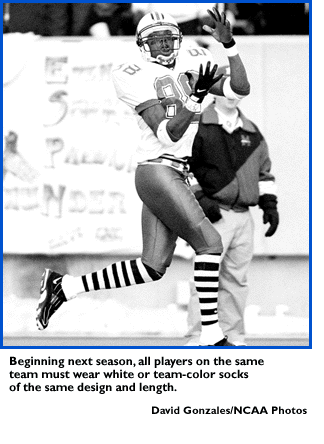
National Collegiate Athletic Association |
The NCAA News - News and FeaturesFebruary 24, 1997 Two-point conversion attempts to be required after second overtime
Football Rules Committee concerned about impact of lengthy overtime gamesA measure to reduce the possibility of a game going into four or more overtimes was among several safety-related rules changes approved by the NCAA Football Rules Committee during its annual meeting February 11-13 in Tempe, Arizona.
After hearing reports on the effect that lengthy overtime games had on players last season, the committee approved a rule requiring a team that scores a touchdown to attempt a two-point conversion, beginning in the third overtime period. Extra-point kicks will be disallowed. Because two-point conversion attempts are approximately half as successful as extra-point kicks at all levels of college football, the committee believes that requiring two-point attempts will reduce the number of times both teams score the same number of points in a period after the second overtime. One reason for this is that the two teams' abilities to convert a two-point attempt are likely to vary more than their abilities to kick extra points. Although the average number of extra periods in an overtime game in 1996 was 1.62 in Division I-A and 1.83 in Division I-AA, eight of the 49 overtime games in the two divisions lasted three or more extra periods. "Historically, the safety of the student-athlete has been the paramount concern of the Football Rules Committee," said committee chair Vincent J. Dooley, director of athletics at the University of Georgia. "While the committee remains committed to resolving all games through the use of overtime, as it was when it mandated the use of the tiebreaker for all divisions last season, it believes this is a reasonable step to help protect the players against the possibility of having to play in extraordinarily long games in which they are more likely to be injured." The committee also approved a rule requiring a game to be declared a tie if it is in overtime but cannot be finished due to weather, darkness or other conditions. Illegal blocks In another safety-related change, the committee adjusted the rules to require more blocks to be penalized as illegal chop blocks. Under the previous rule, a chop block was defined as a delayed block at the thigh or below against an opponent who is in contact with a teammate of the blocker. Such a block was considered delayed if it occurred more than one second after the teammate's initial contact. The change allows a chop block to be called if the low block is "obviously delayed," which could mean less than a second after initial contact, and if the opponent has just disengaged contact with the blocker's teammate. It also prohibits certain types of combination blocks that previously were legal. The committee also added restrictions to another potentially dangerous technique: the "crack-back" block, which is a block below the waist by any wide receiver or a player in motion toward the ball at the snap. Previously, such a block was illegal anywhere on the field until the ball crossed the line of scrimmage. The committee voted to make the block illegal up to five yards beyond the line of scrimmage regardless of the position of the ball, which increases the amount of time during which such a play can be penalized. In an effort to prompt more players to wear their required mouth guards, the committee voted to allow officials to interrupt the 25-second count if a player obviously does not have his in place. Once the clock is stopped, the player's team will be charged a timeout; if the team has used its three timeouts of the half, a five-yard penalty will be enforced. The player can remain in the game if he has his mouth guard with him. Dooley said the change was a result of the committee's ongoing concern about concussion rates. "The presence of a properly fitted mouth guard has been shown to reduce the likelihood of a player sustaining a concussion," he said. "Although injury statistics indicate that the rate of concussions in college football did not increase last season, concussions have become a point of concern at all levels of play, and our committee believes it is important to send a clear message that wearing a mouth guard is an important safety measure that should no longer be ignored by a significant number of players." Punt returners, who are extremely vulnerable while they are looking up to receive a kick, will receive added protection from a stiffer penalty for coming within six feet of the returner before he has caught the ball and then roughing him. The committee hopes that changing the penalty from five to 15 yards will prevent punting-team players from leveling returners with unnecessarily vicious hits. As a continuation of its recent efforts to standardize player appearance, the committee voted to require all players on the same team to wear white or team-color socks of the same design and length. Leg coverings such as tights, if worn, must be in team colors and of a uniform design for all players on the same team. The committee also recommend that all players wear full-length, tucked-in jerseys, effective in 1999. This recommendation is subject to Executive Committee approval.
Other highlights
Football Rules Committee
Site Content and Development copyright © 1997 National Collegiate Athletic Association
|
 The committee also expanded the definition of an illegal chop block, further restricted "crack-back" blocking, allowed officials to stop an imminent play if a player is not wearing a mouth guard, and increased the penalty for unnecessarily violent hits on punt returners.
The committee also expanded the definition of an illegal chop block, further restricted "crack-back" blocking, allowed officials to stop an imminent play if a player is not wearing a mouth guard, and increased the penalty for unnecessarily violent hits on punt returners.